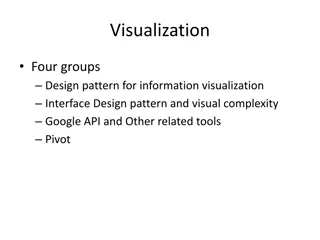Design Patterns in Software Development
Design patterns offer standard solutions to common programming problems, promoting code flexibility, modularity, and readability. Examples like Observer and Iterator patterns demonstrate how these patterns work, addressing issues such as reusability and data traversal efficiency. By utilizing design patterns, developers can enhance communication, improve problem-solving abilities, and overcome language-specific limitations in software design.
Download Presentation

Please find below an Image/Link to download the presentation.
The content on the website is provided AS IS for your information and personal use only. It may not be sold, licensed, or shared on other websites without obtaining consent from the author.If you encounter any issues during the download, it is possible that the publisher has removed the file from their server.
You are allowed to download the files provided on this website for personal or commercial use, subject to the condition that they are used lawfully. All files are the property of their respective owners.
The content on the website is provided AS IS for your information and personal use only. It may not be sold, licensed, or shared on other websites without obtaining consent from the author.
E N D
Presentation Transcript
CSE 331 Software Design & Implementation James Wilcox & Kevin Zatloukal Fall 2022 Design Patterns
What is a design pattern? A standard solution to a common programming problem solution is usually language independent sometimes a problem with some programming languages Often a technique for making code more flexible [modularity] reduces coupling among program components (at some cost) Shorthand description of a software design [readability] a high-level programming idiom well-known terminology improves communication makes it easier to think of using the technique A couple familiar examples . CSE 331 Fall 2022 2
Example 1: Observer Problem: other code needs to be called each time state changes but we would like the component to be reusable can t hard-code calls to everything that needs to be called Solution: object maintains a list of observers with a known interface calls a method on each observer when state changes Disadvantages: code can be harder to understand wastes memory by maintaining a list of objects that are known a priori (and are always the same) CSE 331 Fall 2022 3
Example 2: Iterator Problem: accessing all members of a collection requires performing a specialized traversal for each data structure (makes clients strongly coupled to that data structure) Solution: the implementation performs traversals, does bookkeeping results are communicated to clients via a standard interface (e.g., hasNext(), next()) Disadvantages: less efficient: creates extra objects, runs extra code iteration order fixed by the implementation, not the client (you can have return different types of iterators though...) CSE 331 Fall 2022 4
Why (more) design patterns? Design patterns are intended to capture common solutions / idioms, name them, make them easy to use to guide design language independent high-level designs, not specific coding tricks They increase your vocabulary and your intellectual toolset Often important to fix a problem in the underlying language: limitations of Java constructors lack of named parameters to methods lack of multiple dispatch CSE 331 Fall 2022 5
Why not (more) design patterns? As with everything else, do not overuse them introducing new abstractions to your program has a cost it can make the code more complicated it takes time don t fix what isn t broken wait until you have good evidence that you will run into the problem that pattern is designed to solve CSE 331 Fall 2022 6
Origin of term The Gang of Four (GoF) Gamma, Helm, Johnson, Vlissides examples in C++ and SmallTalk Found they shared several tricks and decided to codify them a key rule was that nothing could become a pattern unless they could identify at least three real [different] examples for object-oriented programming some patterns more general others compensate for OOP shortcomings CSE 331 Fall 2022 7
P atterns vs patterns The phrase pattern has been overused since GoF book Often used as [somebody says] Xis a good way to write programs and anti-pattern as Yis a bad way to write programs These are useful, but GoF-style patterns are more important they have richness, history, language-independence, documentation and (most likely) more staying power CSE 331 Fall 2022 8
An example GoF pattern For some class C, guarantee that at run-time there is exactly one (globally visible) instance of C First, why might you want this? what design goals are achieved? Second, how might you achieve this? how to leverage language constructs to enforce the design A pattern has a recognized name this is the Singleton pattern CSE 331 Fall 2022 9
Possible reasons for Singleton One RandomNumber generator One KeyboardReader, PrinterController, etc One CampusPaths? Have an object with fields / methods that are like public, static fields / methods but have a constructor decide their values cannot be static because need run time info to create e.g., have main decide which files to give CampusPaths rest of the code can assume it exists Other benefits in certain situations could delay expensive constructor until needed CSE 331 Fall 2022 10
How: multiple approaches public class Foo { private static final Foo instance = new Foo(); // private constructor prevents instantiation outside class private Foo() { } public static Foo getInstance() { return instance; } instance methods as usual } Eager allocation of instance public class Foo { private static Foo instance; // private constructor prevents instantiation outside class private Foo() { } public static synchronized Foo getInstance() { if (instance == null) { instance = new Foo(); } return instance; } instance methods as usual } CSE 331 Fall 2022 Lazy allocation of instance 11
GoF patterns: three categories Creational Patterns are about the object-creation process Factory Method, Abstract Factory, Singleton, Builder, Prototype, Structural Patterns are about how objects/classes can be combined Adapter, Bridge, Composite, Decorator, Fa ade, Flyweight, Proxy, Behavioral Patterns are about communication among objects Command, Interpreter, Iterator, Mediator, Observer, State, Strategy, Chain of Responsibility, Visitor, Template Method, Green = ones we ve seen already CSE 331 Fall 2022 12
Creational patterns Especially large number of creational patterns Key reason is that Java constructors have limitations... 1. Can't return a subtype of the class 2. Can t reuse an existing object 3. Don t have useful names Factories: patterns for how to create new objects Factory method, Factory object / Builder, Prototype Sharing: patterns for reusing objects Singleton, Interning CSE 331 Fall 2022 13
Motivation for factories: Changing implementations Super-types support multiple implementations interface Matrix { ... } class SparseMatrix implements Matrix { ... } class DenseMatrix implements Matrix { ... } Clients use the supertype (Matrix) BUT still call SparseMatrix or DenseMatrix constructor must decide concrete implementation somewhere might want to make the decision in one place rather than all over in the code part that knows what to create could be far from uses factory methods put this decision behind an abstraction CSE 331 Fall 2022 14
Use of factories class MatrixFactory { public static Matrix createMatrix(float density) { return (density <= 0.1) ? new SparseMatrix() : new DenseMatrix(); } } Clients call createMatrix instead of a particular constructor Advantages: to switch the implementation, change only one place CSE 331 Fall 2022 15
DateFormat factory methods DateFormat class encapsulates how to format dates & times options: just date, just time, date+time, w/ timezone, etc. instead of passing all options to constructor, use factories the subtype created by factory call need not be specified factory methods (unlike constructors) have useful names DateFormat df1 = DateFormat.getDateInstance(); DateFormat df2 = DateFormat.getTimeInstance(); DateFormat df3 = DateFormat.getDateInstance( DateFormat.FULL, Locale.FRANCE); Date today = new Date(); df1.format(today); // "Jul 4, 1776" df2.format(today); // "10:15:00 AM" df3.format(today); // "jeudi 4 juillet 1776" CSE 331 Fall 2022 16
Example: Bicycle race class Race { public Race() { Bicycle bike1 = new Bicycle(); Bicycle bike2 = new Bicycle(); // assume lots of other code here } } Suppose there are different types of races Each race needs its own type of bicycle CSE 331 Fall 2022 17
Example: Tour de France class TourDeFrance extends Race { public TourDeFrance() { Bicycle bike1 = new RoadBicycle(); Bicycle bike2 = new RoadBicycle(); } } The Tour de France needs a road bike CSE 331 Fall 2022 18
Example: Cyclocross class Cyclocross extends Race { public Cyclocross() { Bicycle bike1 = new MountainBicycle(); Bicycle bike2 = new MountainBicycle(); } } And the cyclocross needs a mountain bike. Problem: must override the constructor in every Race subclass just to use a different subclass of Bicycle CSE 331 Fall 2022 19
Factory method for Bicycle class Race { Bicycle createBicycle() { return new Bicycle(); } public Race() { Bicycle bike1 = createBicycle(); Bicycle bike2 = createBicycle(); ... } } Solution: use a factory method to avoid choosing which type to create let the subclass decide by overriding createBicycle CSE 331 Fall 2022 20
Subclasses override factory method class TourDeFrance extends Race { Bicycle createBicycle() { return new RoadBicycle(); } } class Cyclocross extends Race { Bicycle createBicycle() { return new MountainBicycle(); } } Requires foresight to use factory method in superclass constructor Subtyping in the overriding methods! Supports other types of reuse (e.g. addBicycle could use it too) CSE 331 Fall 2022 21
A Brief Aside Did you see what that code just did? it called a subclass method from a constructor! factory methods should usually be static methods CSE 331 Fall 2022 22
Super/Subclass Coupling Examples of tight coupling between subclass and superclass: presence of self-calls subclass can see which methods call which others order of calls self-calls subclass can see which method is called first (distinct from the previous case) subclass calls where rep invariant does not hold sometimes necessary in the superclass (e.g., when mutating) subclass can see that the state is invalid EJ: Either design for inheritance or prohibit it (make class final) CSE 331 Fall 2022 23
Factory objects Let s move the method into a separate class so that it is part of a factory object Advantages: no longer risks horrifying bugs can pass factories around at runtime e.g., let main decide which one to use Disadvantages: uses bit of extra memory debugging can be more complex when decision of which object to create is far from where it is used CSE 331 Fall 2022 24
Factory objects/classes encapsulate factory method(s) class BicycleFactory { Bicycle createBicycle() { return new Bicycle(); } } class RoadBicycleFactory extends BicycleFactory { Bicycle createBicycle(){ return new RoadBicycle(); } } class MountainBicycleFactory extends BicycleFactory { Bicycle createBicycle(){ return new MountainBicycle(); } } These are returning subtypes CSE 331 Fall 2022 25
Using a factory object class Race { BicycleFactory bfactory; public Race(BicycleFactory f) { bfactory = f; Bicycle bike1 = bfactory.createBicycle(); Bicycle bike2 = bfactory.createBicycle(); } public Race() { this(new BicycleFactory()); } } Setting up the flexibility here: Factory object stored in a field, set by constructor Can take the factory as a constructor-argument But an implementation detail (?), so 0-argument constructor too Java detail: call another constructor in same class with this CSE 331 Fall 2022 26
The subclasses class TourDeFrance extends Race { public TourDeFrance() { super(new RoadBicycleFactory()); } } class Cyclocross extends Race { public Cyclocross() { super(new MountainBicycleFactory()); } } Voila! Just call the superclass constructor with a different factory Raceclass had foresight to delegate what to do to create a bicycle to the factory object, making it more reusable CSE 331 Fall 2022 27
Separate control over bicycles and races class TourDeFrance extends Race { public TourDeFrance() { super(new RoadBicycleFactory()); // or this( ) } public TourDeFrance(BicycleFactory f) { super(f); } } By having factory-as-argument option, we can allow arbitrary mixing by client: new TourDeFrance(new TricycleFactory()) Less useful in this example: Swapping in different factory object whenever you want Reminder: Not shown here is also using factories for creating races CSE 331 Fall 2022 28
Builder Builder: object with methods to describe object and then create it fits especially well with immutable classes when clients want to add data a bit at a time (mutable Builder creates immutable object) Example 1: StringBuilder StringBuilder buf = new StringBuilder(); buf.append( Total distance: ); buf.append(dist); buf.append( meters ); return buf.toString(); CSE 331 Fall 2022 29
Builder Builder: object with methods to describe object and then create it fits especially well with immutable classes when clients want to add data a bit at a time (mutable Builder creates immutable object) Example 2: Graph.Builder addNode, addEdge, and createGraph methods (static inner class Builder can use private constructors) containsNode etc. may not need to be especially fast CSE 331 Fall 2022 30
Enforcing Constraints with Types These examples use the type system to enforce constraints Constraint is that some methods should not be called until after the finish method has been called solve by splitting type into two parts Builder part has everything that can be called before finish normal object has everything that can be called after finish This approach can be used with other types of constraints Instead of asking clients to remember not to violate them, see if you can use type system to enforce them use tools rather than just reasoning (This can be done in a general manner, but it s way out of scope for this class.) CSE 331 Fall 2022 31
Builder Idioms Builder classes are often written like this: class FooBuilder { public FooBuilder setX(int x) { this.x = x; return this; } public Foo build() { ... } } so that you can use them like this: Foo f = new FooBuilder().setX(1).setY(2).build(); CSE 331 Fall 2022 32
Methods with Many Arguments Builders useful for cleaning up methods with too many arguments recall the problem that clients can easily mix up argument order E.g., turn this myMethod(x, y, true, false, true); into this myMethod(x, y, Options.create() .setA(true) .setB(false) .setC(true).build()); This simulates named (rather than positional) argument passing. CSE 331 Fall 2022 33
Prototype pattern Each object is itself a factory: objects contain a clone method that creates a copy Useful for objects that are created via a process Example: java.awt.geom.AffineTransform create by a sequence of calls to translate, scale, etc. easiest to make a similar one by copying and changing Example: android.graphics.Paint Example: JavaScript classes use prototypes so every instance doesn t have all methods stored as fields CSE 331 Fall 2022 34
Factories: summary Goal: want more flexible abstractions for what class to instantiate Factory method call a method to create the object method can do any computation and return any subtype Factory object (also Builder) Factory has factory methods for some type(s) Builder has methods to describe object and then create it Prototype every object is a factory, can create more objects like itself call clone to get a new object of same subtype as receiver CSE 331 Fall 2022 35























